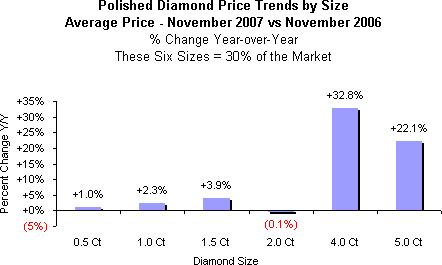IDEX Online Research: Polished Diamond Prices Rise Significantly in November
December 03, 07
Fueled by sharply higher prices of three carats and larger, global polished diamond prices rose a significant 3.6 percent in November versus the same month a year ago, according to the IDEX Online Polished Diamond Price Index. This was by far the largest gain this year, and is at the very high end of the overall long term price inflation rate in the polished diamond industry.
On a month-to-month basis, polished diamond prices in November rose by 0.4 percent from October. On an annualized basis, this equates to a 4.8 percent price inflation, somewhat above the year-over-year price increase of polished diamonds. This means that near term momentum is pushing prices higher, which suggests that diamond prices are set to rise further in December.
The graph below summarizes the IDEX Online Polished Diamond Price Index from January 2006 through November 2007. This graph represents the composite average prices of all diamonds traded at the wholesale level. It is clear that diamond prices are posting solid gains, especially during 2007.
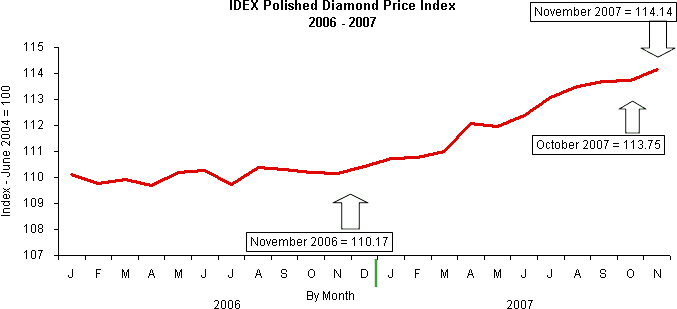
Source: IDEX Online Research
Despite market uncertainty, especially in the U.S. where the economy has softened and consumer discretionary income is under siege by higher energy prices and larger mortgage payments, global polished diamond prices continue to rise steadily.
We believe that most of the increase in diamond prices is driven by three key factors: 1) strong demand for larger, better quality gemstones in most markets worldwide; 2) higher rough diamond prices which are now flowing through the diamond pipeline to the polished diamond market; and, 3) a falling U.S. dollar. The weak U.S. dollar is problematic for the diamond industry. For mining companies and diamond suppliers who have non-dollar denominated costs but collect revenues in dollar-denominated commodities (diamonds), their revenues are not rising as fast as their costs.
Further, these suppliers are under increased pressure from banks that make loans to them based on the value of their inventory. Each day the U.S. dollar falls, the value of the suppliers’ inventories shrinks; this pushes them closer to the brink of their banks’ lending limits, which effectively caps their growth. If suppliers can keep diamond prices rising, then the value of their inventories can perhaps offset the declining value of the U.S. greenback.
On the other hand, consumer demand for stones two carats and smaller has weakened, and, in response, prices have either remained flat or fallen. IDEX Online research has polled a sampling of American retail jewelers who confirm that their polished diamond suppliers appear to be overstocked with two carat and smaller stones. These retailers report that their diamond suppliers are now offering memo (consignment) goods for smaller size diamonds, in contrast to a year ago when memo goods simply were not available due to strong demand.
Further, the contrast in demand – strong for large, high quality stones and weaker for smaller stones – also reflects the bifurcated American retail jewelry market. Mass market jewelers such as Zale, Finlay and Kay have been reporting nearly flat same-store sales trends, while upscale guild jewelers such as Tiffany and Harry Winston are reporting robust same-store sales gains.
Outlook Calls for Higher Polished Prices
The prospect of higher polished diamond prices looms large, based on higher rough prices, strong demand for larger diamonds and the falling U.S. dollar.
On the other hand, the risk of a recession in 2008 in the American market continues to increase. Consumers in the U.S. buy about half of the world’s diamonds and diamond jewelry by value, so if their demand softens significantly, the diamond pipeline will become clogged with inventory and prices will likely soften.
However, even in the face of uncertain demand in 2008, retail jewelers such as Signet Group – parent company of Sterling Jewelers which operates Kay, Jared, and some regional brands in the U.S. market – have sent a signal to the industry that they plan to raise retail jewelry prices in early 2008, rather than continuing to absorb higher producer prices. The implications of this announcement are complex. Essentially, though, it will allow both suppliers and other retailers to justify higher prices, though there will be bumps in the road to higher retail prices.
Typically, when the U.S. economy slows, jewelry demand falls first, further, and faster than other retail categories. Based on trends which began late in the third calendar quarter, it appears that diamond and jewelry demand in the American market may be waning. In other words, 2008 could be a tough year for the global diamond industry.
November 2007 versus October 2007 +0.4 percent
 |
The IDEX Online Polished Diamond Price Index, calculated on the average daily prices during November 2007, stood at 114.14 for the month, up moderately from 113.75 in October (The Index stood at 100.00 in July 2004.). Prices early in the month of November were up sharply, and then held steady later in the month, with a spike at the end of the 30-day period.
There was some significant day-to-day price volatility during the month which reflected uncertainty about diamond demand in the U.S. in the current holiday season. We believe that polished diamond prices will continue to rise for the foreseeable future, based on current economic and consumer trends.
November 2007 versus November 2006 +3.6 percent
 |
November Month-to-Month Price Increase is Third Largest of 2007
IDEX Online Research believes that month-to-month comparisons are not particularly valid, because seasonal demand trends tend to distort monthly price action. However, some diamond dealers who like to view the market on a short term basis use monthly price changes to gauge their business.
The percentage change comparisons on the graph are based on the daily average prices during the month of all sizes and qualities of polished diamonds. The percentage change shown is based on each month’s average price versus the prior month’s average price (e.g. November 2007 versus October 2007).
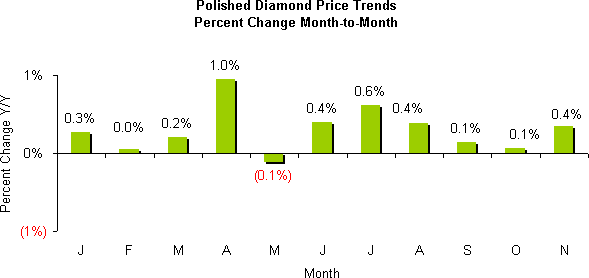
Source: IDEX Online
November Year-to-Year Diamond Prices Is Largest This Year
After some softening earlier in the spring, polished diamond prices have continued to show solid gains through November on a year-to-year basis, compared to the same month a year ago. November’s price increase of 3.6 percent was the largest of the year. The graph below summarizes year-to-year monthly polished diamond prices for the global market since the beginning of 2006. Clearly, diamond prices reflect a solid uptrend.
Comparisons are based on the daily average prices during the month versus the same month a year ago. The year-to-year comparison takes into account the seasonality of polished diamond demand and prices.
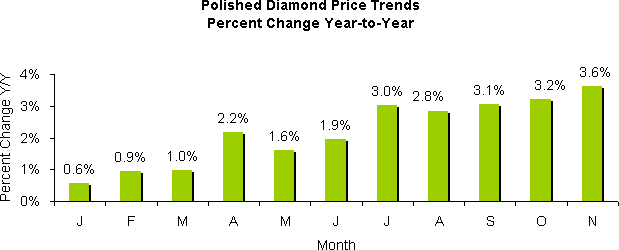 Source: IDEX Online |
Prices Rise Sharply in Early November
The following graph illustrates the average price of polished diamonds on a day-by-day basis in November. Around the middle of the month, prices peaked, and then held relatively steady, followed by a sharp spike at the end of the month.
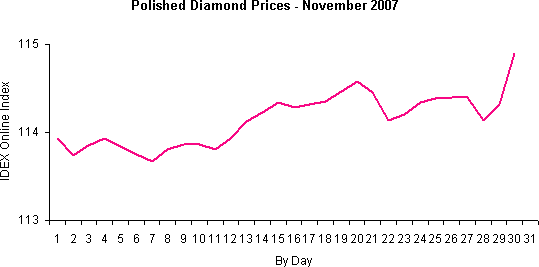 Source: IDEX Online |
Diamond Demand Continues to Favor Large Sizes
Retail jewelers have been saying for some time that their customers want larger, better quality diamonds. Recent price trends for polished diamonds confirm this trend. Further, demand in the all-important American market is bifurcated: mass market jewelers selling stones two carats and under are reporting flat sales, while guild jewelers selling large, better quality stones, especially three carat and above, have generated solid sales gains.
The graph below summarizes the price changes for key sizes of polished diamonds on a month-over-month basis: November 2007 versus October 2007. These six stone sizes represent about 30 percent of the trading market by value.
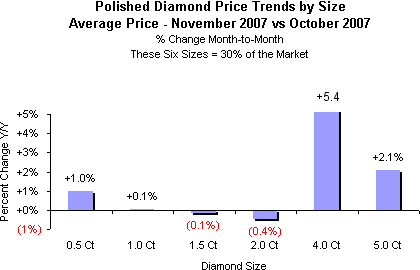 Source: IDEX Online |
On a year-to-year comparison, polished diamond prices showed a greater bias: prices for large stones in the four-to-five carat range rose much more sharply than prices of stones in the two-carat range and below. As the graph illustrates, four carat stones have risen in price by a dramatic 33 percent in the past year.
The graph below summarizes polished diamond prices by key sizes on a year-over-year basis. These sizes represent just under one-third of the market, by aggregate value.
|
|
Forecast: Polished Diamond Prices Likely to Continue Upward
Economists’ forecasts continue to call for the global economy to remain healthy, though there could be some pockets of weaker economic activity in some regions of the world such as Japan and the U.S. The risk of a recession in America in 2008 has increased, though IDEX Online Research believes that the Federal Reserve Open Market Committee has a good grasp on the purse strings of the economy. It may be tricky to engineer the economy in view of the unknown and uncharted territory that it is entering, especially related to mortgage woes, but our current forecast calls for only a slowdown, while avoiding a recession, in 2008.
Assuming that the U.S. does not slip into a protracted economic slowdown, and assuming that other emerging economies continue to post robust growth, demand for diamonds in the global market will remain solid. Further, fueled by higher rough stones and a falling dollar, it is inevitable that polished diamond prices will continue to rise in 2008.
The IDEX Online Diamond Price Index
The IDEX Online Diamond Price Index is a real-time index derived from actual asking prices in the global diamond industry. The IDEX Online Diamond Price Index objectively reflects price trends as they happen. The Diamond Index and Diamond Drivers were formulated following comprehensive research and analysis of the IDEX Online inventory database, aggregated since 2001. Research and development were conducted in cooperation with Dr. Avi Wohl, Senior Lecturer of Finance at the faculty of Management, Tel Aviv University, Israel.
Additional information is available from IDEX Online Research. The e-mail address is diamondprices at idexonline dot com.
